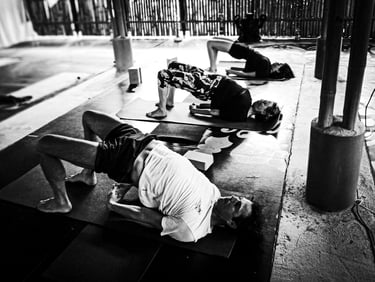Stooping & Spinal Curvature
Your spine has gentle, natural curves in the lower back, middle spine, and upper spine, including the neck. These curves support your head, align your body’s centre over your hips, and absorb the shocks of everyday movement.
How Stooping Develops
For many, ageing brings noticeable changes to posture, including stooping or a rounded upper back. This is often linked to kyphosis, a condition where the spine tilts forward. While mild kyphosis is a normal part of the spine’s structure, exaggerated curvature - known as hyperkyphosis - can develop with age, creating a hunched appearance.
A key contributor to hyperkyphosis is the hardening of spinal discs, which lose flexibility over time. This compression can shift the spine forward. Additionally, muscle loss with age weakens the back’s support system, while weight changes, particularly around the waist, add strain to the spine’s alignment.
Poor posture habits can also lead to stooping. Prolonged slouching stretches the muscles and ligaments supporting the spine, pulling the vertebrae into a rounded shape.
It’s worth noting that while stooping is commonly associated with ageing, kyphosis isn’t exclusive to older adults. It can result from congenital conditions, childhood growth patterns, or other spinal disorders, such as:
Herniated Discs : These can alter spinal alignment, contributing to back pain and posture changes. Practising mild backbends can alleviate discomfort by improving spinal extension and reducing pressure on affected discs.
Spinal Stenosis : Narrowing of the spinal canal can affect posture and mobility, especially when nerves are compressed. Reclining Knee-to-Chest is a common recommendation for spinal stenosis, as it gently stretches the lower back, promotes spinal decompression, and can help alleviate pressure on the nerves.
Why Stooping Matters
Stooping doesn’t just affect appearance. Left unaddressed, it can lead to discomfort, reduced mobility, and difficulty maintaining balance. If you notice your spine rounding or feel your posture worsening, it’s important to consult a doctor to understand the underlying cause and explore treatment options.
Strategies to Address Stooping
Strengthen Supporting Muscles:
Dandasana (Staff Pose) : is a great choice for addressing stooping as it encourages alignment, strengthens the back and core, and promotes postural awareness. Other poses that can complement this include:
Bhujangasana (Cobra Pose): Gently strengthens the upper back and encourages spinal extension.
Marjaryasana-Bitilasana (Cat-Cow Stretch) : Promotes flexibility and mobility in the spine.
Setu Bandhasana (Bridge Pose) : Strengthens the lower back, glutes, and hamstrings while counteracting forward bending.
Tadasana (Palm Tree Pose) : Reinforces the sense of an upright, elongated spine.
Focus on Flexibility : Gentle stretches keep the spine mobile and counteract the effects of stiffness.
Practise Postural Awareness : Regularly check how you stand or sit, and make adjustments to support an upright position.
Adopt Healthy Habits : Maintain a healthy weight, ensure your workspace is ergonomic, and avoid prolonged sitting to reduce strain on your spine.


